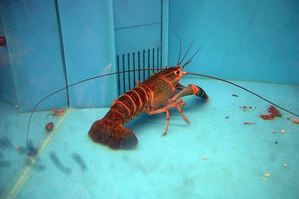Robotic lobsters at the Marine Science Center

Okay, people, you’re going to have to forgive me today.
Here’s the issue: I have incredibly shaky hands. This means that when I try to take videos and photographs they almost always come out blurry.
But I still think that my “footage” (if you can call it that) from the Marine Science Center, which I visited for the first time in daylight today, is viewer-worthy. Not because I think it’s good footage, but because the MSC is so friggin awesome. I felt like a kid in a candy shop as Dan Blustein, a grad student in Joseph Ayers‘ lobster robotics lab, showed me around.
Try not to get nauseous as I take you on this blurry photo tour of the MSC. Perhaps it’ll entice you to go see it for yourself.
While I was in the waiting area I snapped a few pictures of some handmade model ships that were donated by the alum that made them, “for the viewing pleasure of others.” These made me consider building my own model ships…but I’m not sure I’d have the patience (or steady enough hands) for that sort of thing.
Okay, ships are beside the point. The research is really where it’s at in this place. First, Dan (who is awesome and knows three million things or more) showed me the equipment they use to study active neurons inside lobsters and jellyfish. In some cases they actually put an electrode directly into a single neuron and then measure the electrical activity it puts out; they can translate this into a visual waveform or an auditory representation of buzzes and pops.
Next we took a visit to the sea water tank out back. Here’s an image of Dan inside the control room. On the other side of that window, Ayers’ team sets up mazes for lobsters to wander around in. By manipulating the lobsters’ environment and measuring neurological activity at the same time, they can learn about behavior and how it’s governed by the nervous system.
Once they know something about the neurons inside the animal and how they relate to the behaviors it exhibits, they build robotic animals (mostly lobsters, but also lampreys and some other funky dudes) with simulated nervous systems mathematically modeled on the real ones. Unfortunately I was a little excited when I took the pictures of the robot lobsters, so they all came out totally crappy. But you’ll get the idea.
(I went to college with a bunch of art majors and I’m pretty sure some of them are selling blurry photography for good money…just saying.)
Okay, back to the point. Here’s an older lobster robot from Ayers’ lab. It has two claws up front and a boxy body, instead of a cylindrical body. Dan explained that the new design will be better able to handle surges in water flow.
These are the live guys, hiding in the corner of their tank. Dan said they don’t like people much (although I guess I wouldn’t either if they tried to stick electrodes in my neurons).
What in the world are Dan, Ayers and the other people on the team building mechanical robot’s for in the first place, you might ask. The work is funded by the NAVY to develop robots underwater mine countermeasures. Currently, that work is performed by humans. For more info, visit the lab’s website or stay tuned for the news article that will be coming out of my visit today.
cover photo: “blue lobster” April 24, 2005 via opencage.com, Creative Commons Attribution










